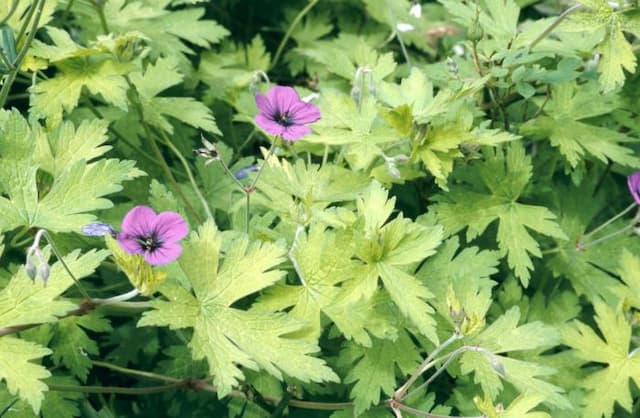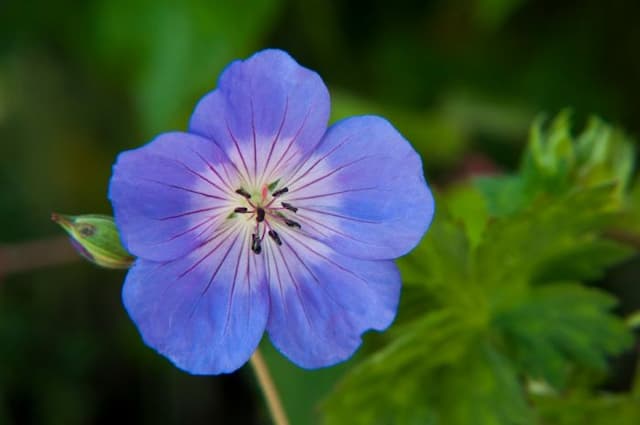Geranium Pelargonium 'Fareham' (R)

ABOUT
The Pelargonium 'Fareham' is known commonly as a type of geranium. It possesses distinctive features that set it apart from other plants in its family. The plant is adorned with lush, green foliage that serves as a backdrop to its prominent blooms. The leaves are rounded with a soft, velvety texture, often having slightly scalloped edges that may showcase a hint of zonal coloring, a common characteristic among geraniums. The flowers manifest in eye-catching clusters, boasting a stunning array of colors that may include various shades ranging from pale pinks to deep, rich reds. Each flower typically has rounded petals, which may be solid in color or display intricate patterns such as veining or blotching. The overall ensemble of blossoms creates a vivid and attractive display. Geraniums such as the 'Fareham' are favored for their continuous blooming habit, which adds long-lasting color and vibrancy to gardens and living spaces. The plant's overall structure is often described as upright and well-branched, forming an elegant and balanced shape that enhances its ornamental appeal.
About this plant
 Names
NamesFamily
Geraniaceae.
Synonyms
Fareham Geranium, Fareham Pelargonium.
Common names
Pelargonium 'Fareham'
 Toxicity
ToxicityTo humans
Geraniums, such as Pelargonium 'Fareham', are not considered highly toxic to humans. However, ingesting them can sometimes lead to minor symptoms such as a mild upset stomach, vomiting, or diarrhea. It is generally advised to keep plants out of reach of small children who might chew on them.
To pets
Geraniums, including Pelargonium 'Fareham', are considered toxic to pets, especially cats and dogs. If ingested, they can cause symptoms such as vomiting, depression, anorexia, and dermatitis. In severe cases, ingestion could potentially lead to more serious health issues, so it is important to keep these plants away from pets and seek veterinary care if there are signs of poisoning.
 Characteristics
CharacteristicsLife cycle
Perennials
Foliage type
Evergreen
Color of leaves
Green
Flower color
Mixed
Height
1-2 feet (30-60 cm)
Spread
1-2 feet (30-60 cm)
Plant type
Herb
Hardiness zones
9
Native area
South Africa
Benefits
 General Benefits
General Benefits- Ornamental Appeal: Pelargonium 'Fareham' adds aesthetic value to gardens and homes with its attractive foliage and vibrant flowers.
- Low Maintenance: This geranium variety generally requires minimal care, making it suitable for busy gardeners and those new to horticulture.
- Drought Tolerance: Once established, Pelargonium 'Fareham' can withstand periods of low water availability.
- Pest Resistance: The plant has a natural resistance to common pests, reducing the need for chemical treatments.
- Long Blooming Period: The geranium blooms over a long season, providing color and interest from spring through fall.
- Versatility: It can be grown in pots, containers, beds, and borders, offering flexible gardening options.
- Attracts Pollinators: The flowers can attract bees and butterflies, benefiting the local ecosystem by supporting pollinator populations.
 Medical Properties
Medical PropertiesThis plant is not used for medical purposes.
 Air-purifying Qualities
Air-purifying QualitiesThis plant is not specifically known for air purifying qualities.
 Other Uses
Other Uses- As a natural dye: The flowers of the geranium can be used to create natural dyes for fabrics, offering shades of pink, red, and purple depending on the mordant used.
- In perfumery: Geranium essential oils are used in perfumes for their rose-like scent, especially in creating floral and aromatic fragrance profiles.
- As a food flavoring: The leaves can add a unique flavor to desserts, jellies, cakes, and teas, infusing them with a subtle rose scent.
- In potpourris: Dried geranium leaves and flowers can be included in potpourris to give a refreshing and long-lasting fragrance to rooms.
- As a companion plant: Planting geraniums in vegetable gardens can help repel pests and attract beneficial insects, protecting nearby plants.
- In craft projects: The bright flowers and leaves can be pressed and used in scrapbooking, greeting card making, or other decorative paper crafts.
- As a natural ink: Crushed geranium flowers can be used to produce botanical inks for art projects or calligraphy.
- For educational purposes: Geraniums can serve as an ideal plant for botany lessons due to their ease of cultivation and propagation through cuttings.
- In sachets: Dried geranium flowers and leaves can be bundled into small sachets to scent drawers and closets.
- For color theming events: The vibrant hues of geranium flowers are perfect for creating color-themed floral arrangements for weddings or other festivities.
Interesting Facts
 Feng Shui
Feng ShuiThe Geranium is not typically referenced in classic Feng Shui practice.
 Zodiac Sign Compitability
Zodiac Sign CompitabilityThe Geranium is not used in astrology practice.
 Plant Symbolism
Plant Symbolism- Comfort: Pelargoniums, commonly referred to as geraniums, often symbolize comfort due to their pleasant scent and the coziness they add to home environments.
- Friendship: Geraniums are also associated with friendship, potentially due to their long-lasting nature and how they can be shared among friends as cuttings.
- Health: Geraniums have a history of being used in traditional medicine, and as such, they can represent health and healing.
- Happiness: The bright and colorful flowers of geraniums are often linked to positivity and general happiness.
 Water
WaterGeraniums like Pelargonium 'Fareham' prefer to be watered thoroughly but infrequently, ensuring that the soil has dried out slightly between watering sessions. Generally, watering every 7 to 10 days during active growth periods should be sufficient. When you do water, provide about one gallon for large pots, making sure to water the soil directly rather than the leaves to avoid fungal diseases. During the winter months, when the plant is not actively growing, reduce the frequency of watering to every two weeks or when the soil is dry to the touch.
 Light
LightGeraniums, including Pelargonium 'Fareham', thrive in bright, indirect light. They are best positioned in a spot that receives plenty of light, such as a south or west-facing window. However, during the peak of summer, it is advisable to protect them from the intense midday sun, which can scorch their leaves.
 Temperature
TemperatureGeraniums like Pelargonium 'Fareham' perform well in a temperature range between 55°F and 75°F. They can tolerate temperatures as low as 30°F for short periods, but frost can damage or kill the plant. Ideally, they should be kept away from drafts and sudden temperature changes for optimal growth.
 Pruning
PruningPrune Geraniums like Pelargonium 'Fareham' to promote bushy growth and remove dead or yellowing leaves. Pruning is best done in early spring before new growth begins. Cut back leggy stems and shape the plant to encourage a more compact form. Deadhead spent blooms regularly to encourage continuous flowering throughout the season.
 Cleaning
CleaningAs needed
 Soil
SoilGeranium 'Fareham' prefers well-draining soil with equal parts of peat, perlite, and potting compost. The best soil pH for geraniums is slightly acidic to neutral, around 6.0 to 7.0.
 Repotting
RepottingGeranium 'Fareham' should be repotted every 1-2 years or when it outgrows its current container. Spring is the ideal time for repotting geraniums.
 Humidity & Misting
Humidity & MistingGeranium 'Fareham' thrives under average room humidity levels; it does not require high humidity and can tolerate dry air.
 Suitable locations
Suitable locationsIndoor
Ensure bright light, not direct sun, and keep soil well-drained.
Outdoor
Place in sun to part-shade; protect from frost and heavy rain.
Hardiness zone
9-12 USDA
 Life cycle
Life cycleThe life cycle of Pelargonium 'Fareham' ('Fareham' Geranium) begins with seed germination, where the plant emerges usually in warm and moist conditions. Following germination, the seedling develops into a young plant through vegetative growth, establishing roots and producing leaves for photosynthesis. As it matures, the geranium enters the flowering stage, where it develops buds that bloom into vibrant flowers, attractive for pollination. After pollination, if occurring, the plant produces seeds, which are then dispersed by various means, such as wind or animal transport. In favorable conditions, these seeds will germinate and start a new life cycle. Some geraniums can also be propagated vegetatively via cuttings, which bypass the seed stage and grow directly into new plants.
 Propogation
PropogationPropogation time
Spring-Early Summer
Pelargonium 'Fareham', commonly known as the Fareham Geranium, is typically propagated through stem cuttings, a method that is both popular and effective for this plant. To propagate, choose a healthy, non-flowering stem and cut a piece around 4 to 6 inches (10 to 15 centimeters) long just below a leaf node using a clean, sharp knife or pair of scissors. Remove leaves from the lower half of the cutting and allow the cut end to callous over for a few hours. Then, insert the cutting into a dampened potting mix, making sure that at least one leaf node is buried where roots will form. Keep the soil moist but not waterlogged and place the cutting in a warm spot with indirect sunlight. Roots typically develop within a few weeks, after which the new Fareham Geranium plant can eventually be transplanted into a larger pot or garden setting.









